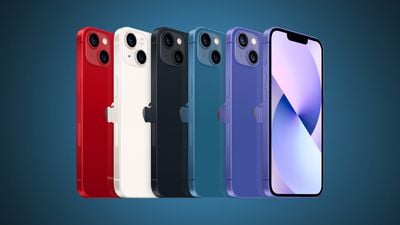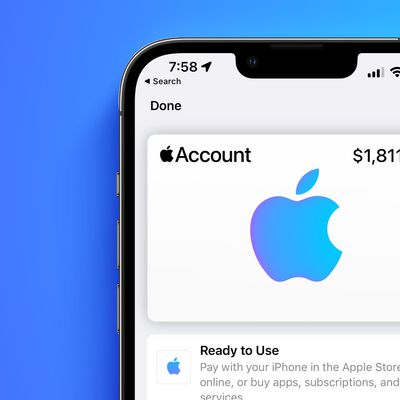Global Smartphone Shipments to Decline 3.5% in 2022, Apple to Be Least Impacted
Global smartphone shipments are expected to decline 3.5 percent to 1.31 billion units in 2022, according to IDC's latest Worldwide Quarterly Mobile Phone Tracker forecast. Because of increasing challenges with supply and demand, IDC is significantly reducing its forecast for 2022, which previously predicted 1.6 percent growth.

IDC believes Apple will be the "least impacted vendor" because of its control over its supply chain and because iPhone customers are in the higher-priced segment and are not as impacted by macroeconomic issues like inflation.
Weakening demand, inflation, supply chain constraints, and geo-political tensions are impacting all smartphone vendors, resulting in cutbacks. Even major smartphone manufacturers like Samsung and Apple have cut orders. IDC says that it expects the challenges to ease by the end of the year, barring any new setbacks. The 2023 market is expected to recover with 5 percent growth.
Semiconductor supply issues are also expected to ease in the second half of 2022.
"The ongoing semiconductor supply issues will ease up in the second half of 2022. On the SoC side, 4G SoC supply has been tight, but the market continues to shift towards 5G SoCs," said Phil Solis, research director in IDC's Enabling Technologies and Semiconductors team. "The bigger problem has been the tight supply of components such as PMICs, display drivers, and discrete Wi-Fi chips. Capacity is being increased for these semiconductors that are made in higher process nodes and newer versions of Wi-Fi chips are being made with newer process nodes. At the same time, demand is dropping. Combined, these supply and demand changes will put the market more in equilibrium."
Apple in the second fiscal quarter of 2022 had difficulty meeting demand for the current iPhone, iPad, and Mac models because of supply constraints, and the company said in April that it expects those issues to continue into the third fiscal quarter. At the current time, the Mac and iPad appear much more affected by supply chain issues than the iPhone.
Recent rumors have suggested that the iPhone 14 Max is several weeks behind schedule compared to the other iPhone 14 models due to supply chain issues, but Apple analyst Ming-Chi Kuo has said that Apple has the situation under control and suppliers are going to be able to work overtime to watch up. Whether or not these supply issues result in delays or fewer iPhones available for purchase in September remains to be seen.
Popular Stories
Since the iPhone X in 2017, all of Apple's highest-end iPhone models have featured either stainless steel or titanium frames, but it has now been rumored that this design decision will be coming to an end with the iPhone 17 Pro models later this year.
In a post on Chinese social media platform Weibo today, the account Instant Digital said that the iPhone 17 Pro models will have an aluminum...
Apple is continuing to refine and update iOS 26, and beta three features smaller changes than we saw in beta 2, plus further tweaks to the Liquid Glass design. Apple is gearing up for the next phase of beta testing, and the company has promised that a public beta is set to come out in July.
Transparency
In some apps like Apple Music, Podcasts, and the App Store, Apple has toned down the...
The calendar has turned to July, meaning that 2025 is now more than half over. And while the summer months are often quiet for Apple, the company still has more than a dozen products coming later this year, according to rumors.
Below, we have outlined at least 15 new Apple products that are expected to launch later this year, along with key rumored features for each.
iPhone 17 Series
iPho...
Apple should unveil the iPhone 17 series in September, and there might be one bigger difference between the Pro and Pro Max models this year.
As always, the Pro Max model will be larger than the Pro model:iPhone 17 Pro: 6.3-inch display
iPhone 17 Pro Max: 6.9-inch displayGiven the Pro Max is physically larger than the Pro, it has more internal space, allowing for a larger battery and...
In 2020, Apple added a digital car key feature to its Wallet app, allowing users to lock, unlock, and start a compatible vehicle with an iPhone or Apple Watch. The feature is currently offered by select automakers, including Audi, BMW, Hyundai, Kia, Genesis, Mercedes-Benz, Volvo, and a handful of others, and it is set to expand further.
Apple has a web page with a list of vehicle models that ...
New renders today provide the best look yet relocated Apple logo and redesigned MagSafe magnet array of the iPhone 17 Pro and iPhone 17 Pro Max.
Image via Majin Bu.
Several of the design changes coming to the iPhone 17 Pro model have been rumored for some time, such as the elongated camera bump that spans the full width of the device, with the LiDAR Scanner and flash moving to the right side.
...
Apple's next-generation iPhone 17 Pro and iPhone 17 Pro Max are just over two months away, and there are plenty of rumors about the devices.
Below, we recap key changes rumored for the iPhone 17 Pro models.
Latest Rumors
These rumors surfaced in June and July:Apple logo repositioned: Apple's logo may have a lower position on the back of the iPhone 17 Pro models, compared to previous...
Apple is expanding the ability to add an Apple Account Card to the Wallet app to more countries, according to backend Apple Pay changes.
With iOS 15.5, Apple updated the Wallet app to allow users to add an Apple Account Card, which displays the Apple credit balance associated with an Apple ID.
If you receive an Apple gift card, for example, it is added to an Apple Account that is also...
In select U.S. states, residents can add their driver's license or state ID to the Wallet app on the iPhone and Apple Watch, providing a convenient and contactless way to display proof of identity or age at select airports and businesses, and in select apps.
Unfortunately, this feature continues to roll out very slowly since it was announced in 2021, with only nine U.S. states, Puerto Rico,...






















